Guest Post by Jocie Brooks
On my daily morning stroll with the kids, something bright red and shiny caught my eye in the green shrubbery lining the trail. It was a perfect salmonberry, and I took a moment to savour its sweet, seedy ripeness. Now that summer is here there is a wealth of edible wild berries to enjoy.
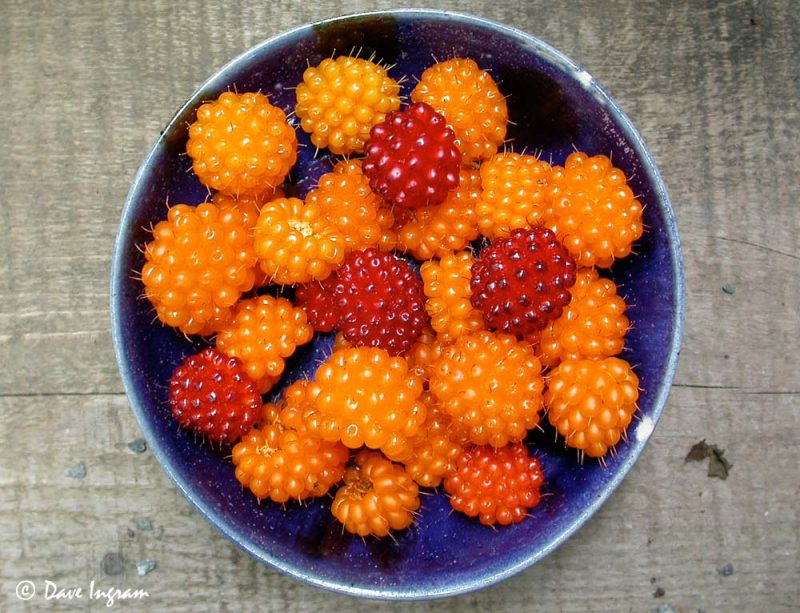
Eating locally sourced foods, including wild foods, has greatly increased in popularity. Wild berries have a very high nutritional value, and can offer many health benefits. Learning about, and sampling edible wild berries is a wonderful way to connect with nature right here in the Comox Valley. It also connects us to history, since wild berries were a staple food of First Nations peoples for thousands of years.
Though there are many edible berries in our area, I’ve come up with a shortlist of five that are easy to find and identify. Bon appetite!
Salmonberry (Rubus spectabilis)
Salmonberry is the first berry to ripen in our area, and can be found from May through to the summer months. The berries vary from golden yellow to orangey red, and are rather like a shiny raspberry. Some claim that salmonberries are insipid, but others think they are divine. Salmonberries have a high water content and can quickly turn to mush, so do not layer very many in a pail.
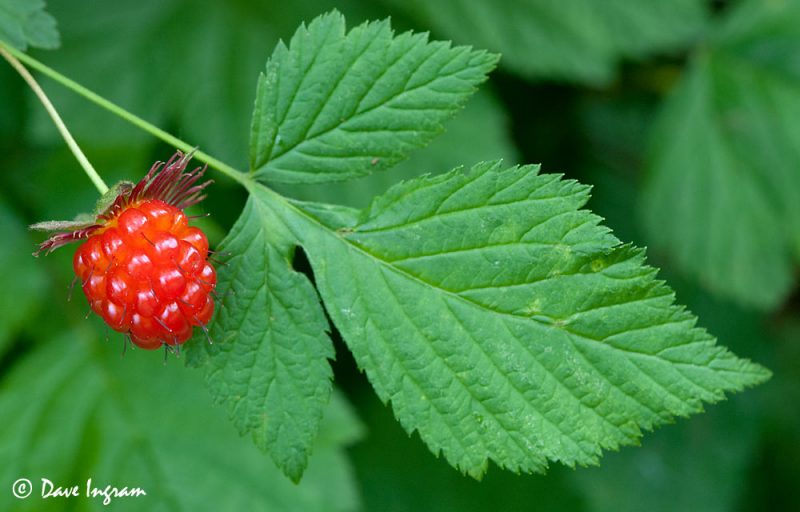
Salmonberry forms dense thickets in moist places, often along streams and rivers. The leaves are green and toothed, and in the early spring it produces pretty pink flowers that look a bit like wrinkled tissue paper. The stems are golden brown and satiny, and there are a few thorns.
Red huckleberry (Vaccinium parvifolium)
The red huckleberry is one of the prettiest woodland shrubs. The delicate oval green leaves and green stems are dotted with bright red berries the size of small peas. Some find the berries to be a bit on the sour side, but they have a nice, refreshing flavour. Though red huckleberries are found at lower elevations, their close relatives, the blueberries are (in our area) found primarily in the mountains.
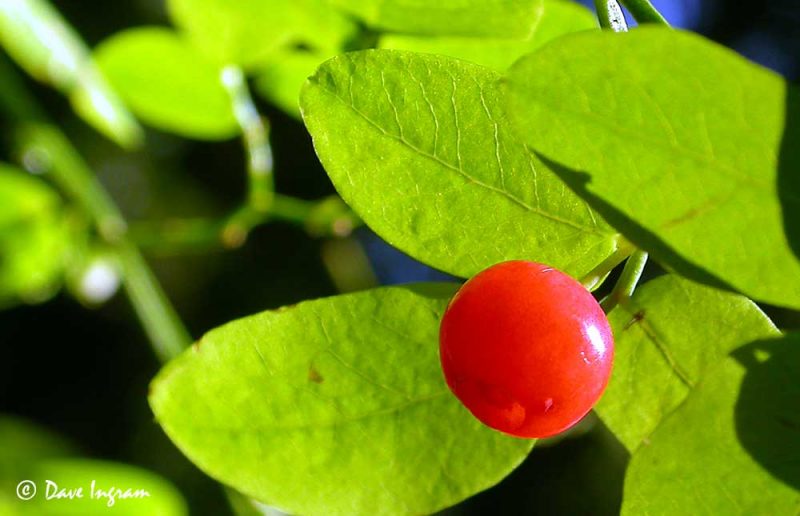
Huckleberry often grows in decaying wood, and may be seen sprouting from the top of an old stump or log. It is found in coniferous forest, or along forest edges.
Thimbleberry (Rubus parviflorus)
Thimbleberries ripen in late June to July. The clusters of rounded berries detach easily from the core, and can be perched thimble-like on the tip of one’s finger. Mature berries are a ruby red colour, and are drier than the more watery salmonberry. Due to the thimbleberry’s course seediness, it is a good berry for drying.
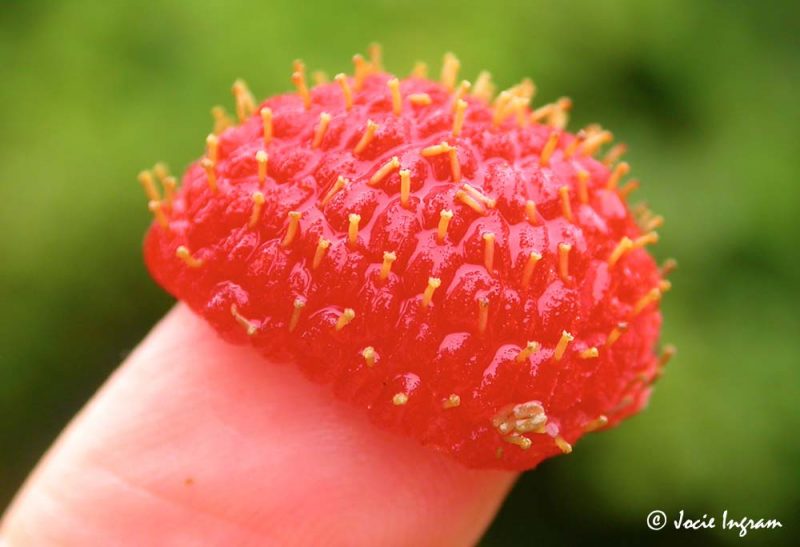
Thimbleberry has soft, fuzzy leaves that are quite large and maple-leaf shaped (they make a good on-the-trail toilet paper). Saucer-like white flowers stand out nicely against the green foliage. Thimbleberry may be found in places that are either moist or quite dry.
Salal (Gaultheria shallon)
Dark purple salal berries are roughly blueberry-sized and grow in rows along the ends of branches. They are very sweet with a mealy texture that some find unpleasant.
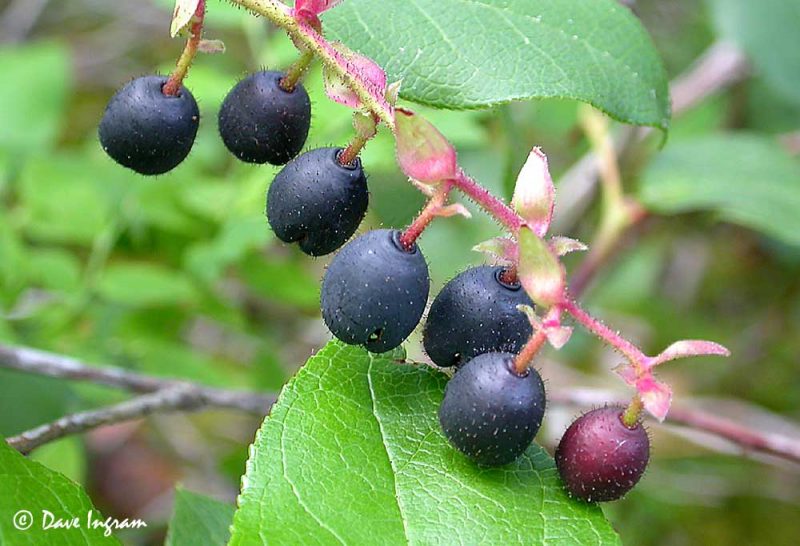
Salal is one of the most common shrubs in the Pacific Northwest. The egg-shaped leaves are thick and leathery, and persist through the winter. They are often used in floral arrangements, and salal harvesting has become quite a big business in BC. Salal has small but attractive bell-like white flowers.
Himalayan Blackberry (Rubus discolor)
The Himalayan blackberry is one of the most familiar and most picked wild berries. Originally introduced from India (via England), Himalayan blackberry is now well established in the Pacific Northwest. Blackberries are juicy and flavorful, and unlike previously mentioned “raspberry” type berries such as salmonberry and thimbleberry, blackberries do not separate from the core. Though popular with pickers, Himalayan blackberries grow vigorously, and their arched, prickly branches can take over native vegetation. For this reason, it is considered an invasive plant, and efforts are ongoing to remove it from many areas.

Trailing blackberry (Rubus ursinus) is the only species of blackberry native to our area, and the berries, which ripen in July, are very good. Much smaller than the Himalayan blackberry, trailing blackberry “trails” along the ground, and often lassos the leg of a person passing by. These delicious native blackberries are worth looking for.
Before heading out with the berry bucket, pack a guidebook (Plants of Coastal British Columbia by Pojar and MacKinnon is a handy reference) to double-check proper identification. Many berries are unpalatable, and a few are poisonous, so it is always best to err on the side of caution if in doubt. Picking is prohibited from Provincial Parks, and even in non-park areas, one should be mindful of the fact that numerous creatures, including bears and many species of birds, may depend upon berries at certain times of the year. Take a few and leave plenty.